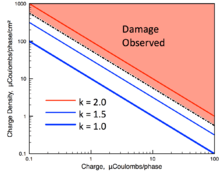Shannon Criteria
The Shannon criteria constitute an empirical rule in neural engineering that is used for evaluation of possibility of damage from electrical stimulation to nervous tissue.[1]
The Shannon criteria relate two parameters for pulsed electrical stimulation: charge density per phase, D (μCoulombs/(phase•cm²)) and charge per phase, Q (μCoulombs/phase) with a dimensionless parameter k:

which can be written alternatively:
According to these criteria, stimulation parameters that yield k ≥ 1.85 (the lowest value where damage was observed in the two studies reported in the original Shannon publication) could cause damage to the adjacent nervous tissue. Currently, this empirical law is applied in neuromodulation for development of implants for cortical, cochlear, retinal,[2][3] and deep brain stimulation.[4][5] Shannon categorizes the relationship between stimulating electrode and target neural tissue as either Near Field, Mid Field, or Far Field, and discusses how equation parameters may be chosen in each case. In the case of spinal cord stimulation,[6] for example, the Far Field category would apply.
Limitations
The data on which the Shannon model was built[7][8] are restricted to experiments performed in cat cerebral cortex with 7 hours of stimulation under light anesthesia at 50 pps with 400 µs pulses (charge-balanced, symmetric, biphasic, anodic-first) using platinum surface disc electrodes of 1 mm² or larger, recessed, anodized sintered tantalum-tantalum pentoxide pellet electrodes of 1 mm in diameter, or iridium penetrating microelectrodes of 6500 µm². As a result of these restricted methods, Shannon states "A more comprehensive model of safe levels for electrical stimulation would also account for the effects of pulse rate, pulse duration, stimulus duty cycle, and duration of exposure."[1] Additionally, further study has demonstrated that microelectrodes do not obey the Shannon criterion, and new approaches may be proposed to address these limitations.[9]
References
- 1 2 Shannon, R.V. (April 1992). "A model of safe levels for electrical stimulation". IEEE Transactions on Biomedical Engineering. 39 (4): 424–426. doi:10.1109/10.126616.
- ↑ Eiber, Calvin D; Lovell, Nigel H; Suaning, Gregg J (1 February 2013). "Attaining higher resolution visual prosthetics: a review of the factors and limitations". Journal of Neural Engineering. 10 (1): 011002. Bibcode:2013JNEng..10a1002E. doi:10.1088/1741-2560/10/1/011002. PMID 23337266.
- ↑ Winter, Jessica O.; Cogan, Stuart F.; Rizzo, Joseph F. (January 2007). "Retinal prostheses: current challenges and future outlook". Journal of Biomaterials Science, Polymer Edition. 18 (8): 1031–1055. doi:10.1163/156856207781494403.
- ↑ Testerman, Roy L; Rise, Mark T; Stypulkowski, Paul H (Sep–Oct 2006). "Electrical stimulation as therapy for neurological disorder". IEEE Engineering in Medicine and Biology Magazine. 25 (5): 74–8. doi:10.1109/memb.2006.1705750. PMID 17020202.
- ↑ Grill, Warren M (July 2005). "Safety considerations for deep brain stimulation: review and analysis". Expert Review of Medical Devices. 2 (4): 409–420. doi:10.1586/17434440.2.4.409.
- ↑ Wesselink, WA; Holsheimer, J; Boom, HB (June 1998). "Analysis of current density and related parameters in spinal cord stimulation". IEEE Transactions on Rehabilitation Engineering. 6 (2): 200–7. doi:10.1109/86.681186. PMID 9631328.
- ↑ McCreery, DB; Agnew, WF (1988). "Comparison of neural damage induced by electrical stimulation with faradaic and capacitor electrodes". Annals of Biomedical Engineering. 16 (5): 463. doi:10.1007/BF02368010. PMID 3189974.
- ↑ McCreery, DB; Agnew, WF (1990). "Charge density and charge per phase as cofactors in neural injury induced by electrical stimulation". IEEE Transactions on Bio-medical Engineering. 37 (10): 996–1001. doi:10.1109/10.102812. PMID 2249872.
- ↑ Cogan SF, Ludwig KA, Welle CG, Takmakov P (2016). "Tissue damage thresholds during therapeutic electrical stimulation". Journal of neural engineering. 13 (2): 021001. Bibcode:2016JNEng..13b1001C. doi:10.1088/1741-2560/13/2/021001. PMC 5386002. PMID 26792176.
Further reading
- Merrill, Daniel R.; Bikson, Marom; Jefferys, John G.R. (February 2005). "Electrical stimulation of excitable tissue: design of efficacious and safe protocols". Journal of Neuroscience Methods. 141 (2): 171–198. doi:10.1016/j.jneumeth.2004.10.020.
- McCreery, Douglas (2004). "Tissue Reaction to Electrodes:The Problem of Safe and Effective Stimulation of Neural Tissue". In Horch, Kenneth W; Dhillon, Gurpreet S. Neuroprosthetics. 2. pp. 592–611. doi:10.1142/9789812561763_0018.